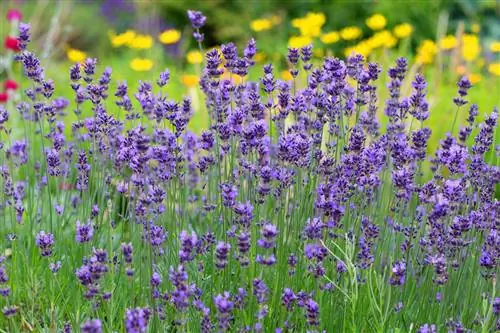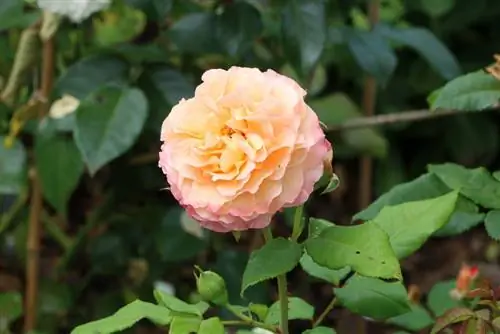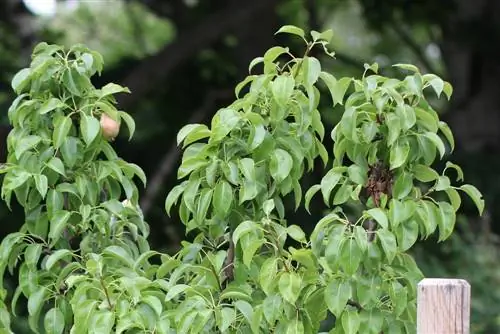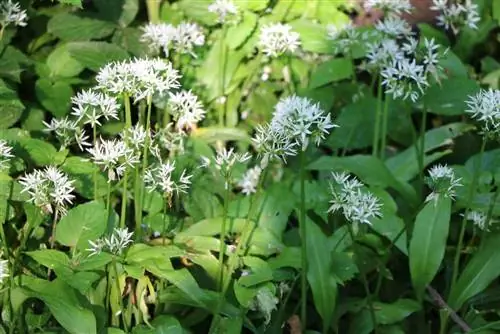- Author admin [email protected].
- Public 2023-12-17 03:39.
- Last modified 2025-06-01 06:48.
Combining lavender with other plants can increase vitality, prevent pest infestations and increase yields. The fragrant herb is considered a favorite of mixed culture. We introduce suitable bed neighbors.
Mixed culture with lavender
While monocultures are the rule in industrial agriculture, organic farmers have relied on mixed culture for generations. More and more hobby gardeners are following this example because the advantages are obvious.
Mixed Culture
- preserves soil fertility
- allows for better use above and below the surface
- strengthens the vitality of plants
- contributes to the preservation of biological diversity
- prevents pest infestation and diseases
- can have positive effects on the aroma of the plants involved
- reduces the need for fertilizers
Influencing the planting partners occurs
- about root exudates
- about fragrances
Appearance as a selection criterion
The lavender plant quickly grows into a subshrub. Its spike-shaped flowers shine blue-violet in summer. New varieties are available in white. The slight hairiness of the narrow gray-green leaves appears like a soft, silvery coating. When making your selection, the visual effect of the combination is also crucial. When planning a bed, you first look at the colors, shapes and sizes of the neighboring plants. If the bed partners harmonize with each other and have similar location requirements, this selection method can work well.
Location requirements of lavender
The basis for a functioning coexistence are similar demands on the location and the quality of the soil. When choosing plant neighbors, consider the requirements of lavender.
- Location: sunny
- Soil: dry, nutrient-rich, calcareous, permeable
- Growth height: 30 to 40 centimeters
- Growth width: 30 to 40 centimeters
- Flowering period: July to September
- Use: flower borders, rose beds, rock gardens, balconies
Effects of lavender on bed neighbors
- increases the production of essential oils in medicinal herbs
- repels the cabbage white butterfly, ants and aphids
Note:
The lavender bush is known for the enchanting scent of its flowers. Check how the aromas interact before combining with other strongly scented plants.
Suitable plant neighbors for lavender A - R
Savory (Satureja)
Savory is suitable as a plant neighbor to lavender on a bed. Both have the same location requirements.
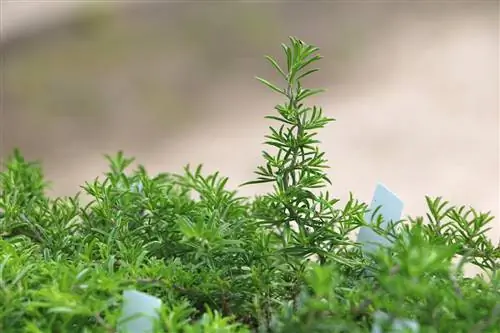
Curry herb (Helichrysum italicum)
With gray-white leaves and golden-yellow flowers, curry herb fits perfectly into the lavender bed.
Ladies Mantle (Alchemilla)
The delicate yellow flowers of the lady's mantle form a great contrast to the purple of the lavender flowers. Both perennials have similar site conditions and feel comfortable next to each other.
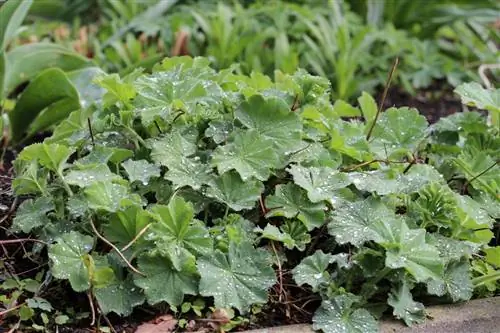
Grass Lily (Anthericum)
Grass lilies and lavender bushes have similar requirements in terms of soil, location and care. The purple lavender flowers and the delicate white lily flowers complement each other well.
Cabbage (Brassica)
All types of cabbage benefit from a combination with lavender plants. The aromatic scent drives away the cabbage white butterfly.
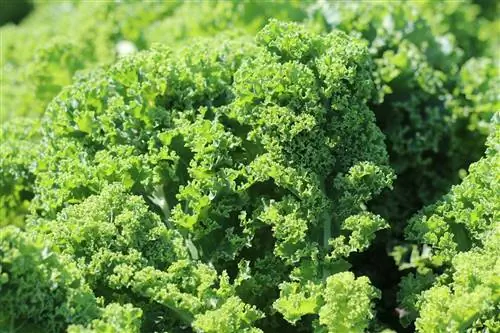
Marigold (Calendula officinalis)
Marigolds benefit from being close to lavender, because without its scent the flowers are often attacked by aphids. The bright yellow or orange flowers look magical next to the purple lavender flowers.

Rose (Pink)
All floribunda roses look very attractive next to lavender bushes. The purple of the lavender flowers creates a magical contrast to red, orange, yellow, pink or cream rose petals. Like lavender, roses love dry, sunny locations. However, roses prefer humus-rich soils. Plant lavender bushes in containers or dig large planting pits in which you provide the nutrient-poor substrate required for lavender plants. A plus point of this partnership is the deterrent effect of lavender on aphids.
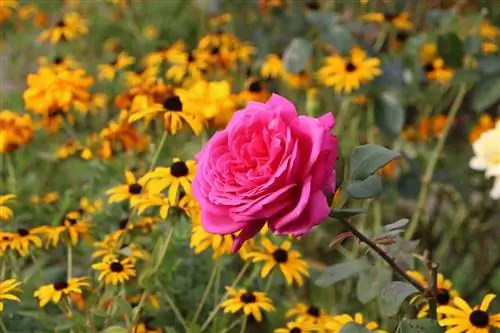
Suitable plant neighbors lavender S - Z
Sage (Salvia officinalis)
Sage, like lavender plants, thrives in sunny, calcareous, nutrient-poor locations. The flowers of both herbs are in the violet color spectrum and complement each other perfectly. The repellent effect of lavender against ants is further enhanced by sage.
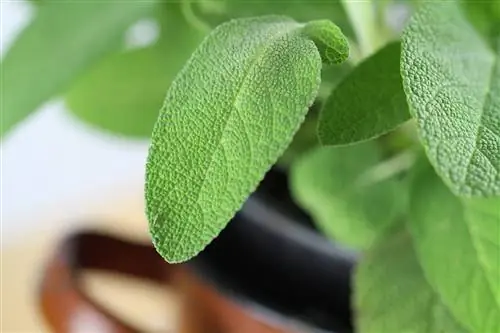
Thyme (Thymus vulgaris)
Thyme is one of the most popular medicinal herbs. Its spicy aroma harmonizes perfectly with the scent of lavender. Small labial flowers in pink to purple appear from May to autumn. Together with purple lavender flowers, a gentle color harmony is created that attracts bees and butterflies as well as the eyes of garden visitors. Thyme prefers dry, sunny locations and, like lavender plants, helps ward off aphids.
Wollziest (Stachys byzantina)
The soft, silver-grey leaves of the Wollziest create enchanting contrasts next to the violet lavender flowers. Both plants love sunny locations and can survive for a long time without watering.
Note:
Lavender is suitable as a plant neighbor for many garden plants. Under no circumstances should the fragrant herb be grown next to parsley. The two plants don't get along!
Hyssop (Hyssopus officinalis)
Hyssop is a beautiful wild herb with purple flowers and dark green foliage. Lavender reveals its full beauty next to hyssop. The spicy herb promotes the development of lavender.
Rockrose (Cistus incanus)
Rockrose is considered to be nature's miracle cure. On the bed, lavender has asserted itself as a good neighbor to the easy-care Mediterranean plant with white or purple flowers.
Note:
In addition to the site conditions, the care characteristics of the bed partners must match. In addition to lavender bushes, only plant varieties that are equally easy to care for and require little moisture.
Lemon balm (Melissa officinalis)
Lemon balm stimulates the growth of lavender. The fresh lemon aroma is a perfect complement to the lavender scent.
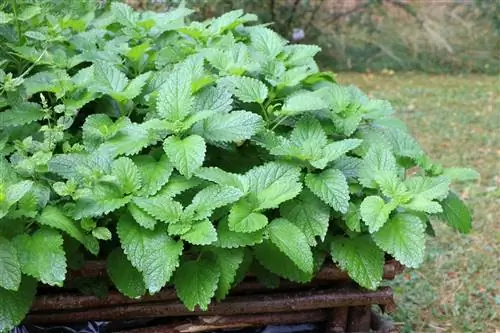
Note:
It makes sense to pay attention to the influence of the plants on each other, not just in the immediate vicinity on a bed, but also on the entire property. Anyone who finds a suitable combination can look forward to he althy plants, good yields and attractive flowers.

